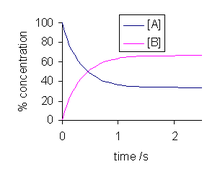This article discusses about the topic “is dynamic equilibrium a system?”. We do not observe any significant change in a system that is under dynamic equilibrium.
Dynamic equilibrium is a type of equilibrium in which the rate of change of substances inside the system are happening at the same rate that is reactants and products are being formed and used at the same rate. Such that we cannot observe any net change in the quantities.
What is dynamic equilibrium?
As we have discussed in above section, dynamic equilibrium is a state of system in which the reactants and products are being formed and used at the same rate.
This happens in such a way that we observe no change in the contents but they continuously changing in reality. On a system, when the opposing forces are acting continuously such that the difference between them is constant or zero then the system is said to be under dynamic equilibrium.

Image credits: Wikipedia
When a system is at dynamic equilibrium?
There are various cases where dynamic equilibrium is taking place. But when is the system actually considered under dynamic equilibrium? Lets see it in the section given below.
- For a chemical reaction, the contents inside the reaction are said to be in dynamic equilibrium when the reaction is occuring reversibly in such a way that the products and reactants are being used up and being formed at the same rate. Such that the contents of the reaction seem to have constant quantities.
- For a system under the application of forces, it is considered to be in dynamic equilibrium when the opposing forces are acting continuously and at the same rate such that the difference between them is constant or zero.
Why is dynamic equilibrium a system?
Dynamic equilibrium refers to space in 3D coordinates where the rates of forward and backward reactions are same. That is the net change inside these coordinates is zero.
Anything happening beyond these coordinates does not relate to dynamic equilibrium. So we can say that these set of coordinates form a system which is under dynamic equilibrium or in simple words dynamic equilibrium is an example of a system.
Is dynamic equilibrium a closed system?
Yes. Dynamic equilibrium is an example of a closed system. The rates at which forward and backward reactions are happening are equal and hence we can say that the system is under steady state.
The contents of the system do not go out of the system except the energies. This is a well known characteristic of a closed system. Hence, we can say that dynamic equilibrium is an example of a closed system.
Can dynamic equilibrium occur in an open system?
In real life, dynamic equilibrium does not occur in open systems. Open systems tend to lose the contents inside the system.
For a system to be in dynamic equilibrium, the contents inside the system cannot leave the system. The container has to be sealed for a reaction to occur under dynamic equilibrium. Hence, we can say that in real life dynamic equilibrium cannot be achieved in an open system.
Can an open system be at equilibrium?
Closed systems are easier to reach the state of equilibrium because the contents do not go out of the system nor any contents enter the system hence minimum change occurs.
As the change is minimum, it takes lesser time to reach equilibrium whereas in open systems, the change is constantly taking place so it gets difficult to reach equilibrium. Usually the open systems are under non equilibrium conditions.
What does not happen during dynamic equilibrium?
As we know the forward rate and backward rate of reactions are same. So the reactants and products form and get used up at the same rate.
As a result of this, we cannot see any change happening inside the system even though the reaction is taking place inside the system.
What does dynamic mean in dynamic equilibrium?
The term dynamic in general means something in constant motion. In dynamic equilibrium the system looks unchanged and static but in reality the reaction is taking place continuously.
Similarly in static equilibrium the contents are same as well as they are static in nature and don’t change without external factors stepping in.
Also Read:
- Isolated system examples
- Is earth a closed system
- Is thermal equilibrium a system
- Isolated system vs closed system
- Closed system example
- System in equilibrium examples
- Catadioptric systems
Hi ….I am Abhishek Khambhata, have pursued B. Tech in Mechanical Engineering. Throughout four years of my engineering, I have designed and flown unmanned aerial vehicles. My forte is fluid mechanics and thermal engineering. My fourth-year project was based on the performance enhancement of unmanned aerial vehicles using solar technology. I would like to connect with like-minded people.